Bike Catalina Island: Mountain Biking and Gravel Riding in California’s Island Paradise
Searching for travel tips on how to bike Catalina Island? Well from sweeping ocean views to the rugged interior, we’ve packed this blog filled with ideas to get you planning a cycling trip to Catalina!
We’ll review the type of bike you’ll need, what to pack, where to stay, and what to expect. So if you’re up for a challenge, but want the beach time too, Catalina packs it all in. And, if you’ve ever traveled through the Meditteranean, this part of California will remind you of those hilly coastal towns in Spain, Greece, and Italy! Bellisima.
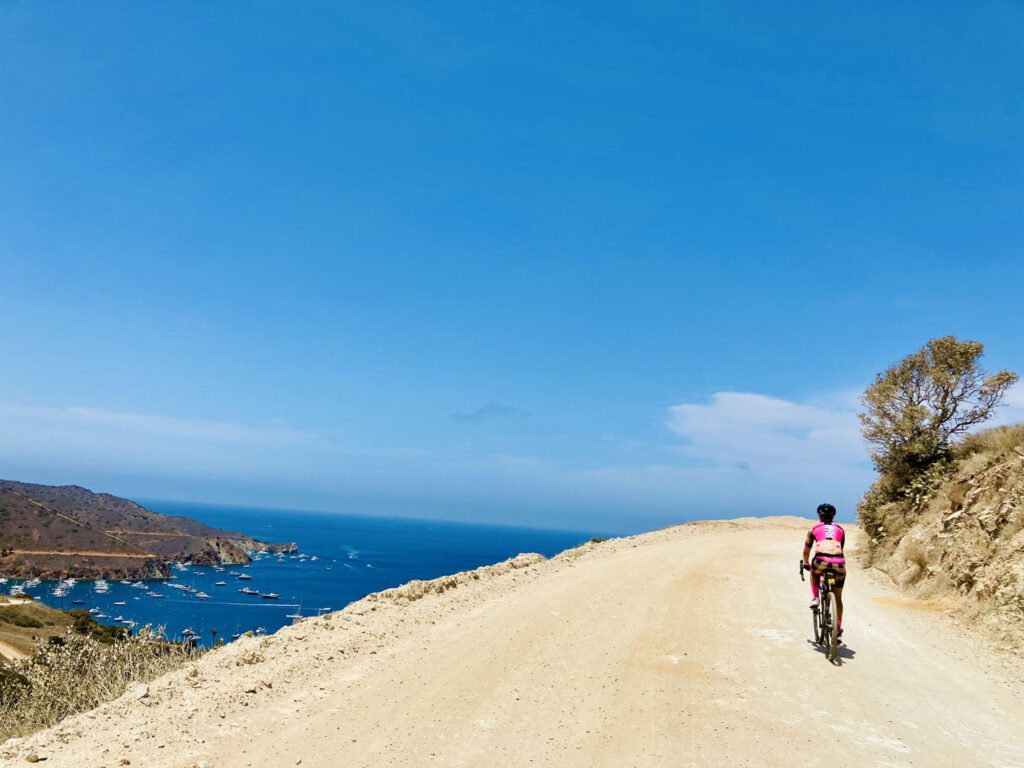
Be ready for lots of gravel roads and pedaling uphill as you bike across Catalina Island!
What You’ll Need to Bike Catalina
Bike Selection
To have a great adventure cycling on Catalina Island, you will want to bring your own gravel or mountain bike. Knobby tires and a squishy suspension will help you absorb all those bumps and broken pavement as you make your way across the island.
No hardtail or full-suspension mountain bike in your stable? How about a gravel bike? If none of the above, your best bet is to purchase the widest knobby tires that will fit your road bike and keep the air pressure on the low side.
Pro tip: Bring everything you need to fix a flat, refill your tubeless tires, or adjust your suspension. There is only 1 legit bike shop on Catalina, Brown’s Bikes, and the likelihood that they will be available on short notice is slim.
For this trip, I rode my gravel bike with a standard crank, 38mm tubeless tires, and ran about 35-40 psi. No flats, no issues, but definitely wish I had more gears or a compact crank in certain sections.
Bike Rentals on Catalina
Want to rent a bike while on Catalina, take a tour, or shuttle one of the routes? Here are a few outfitters that can help with bike rentals and tours:
- Catalina Island Company
- Brown’s Bikes
- Bike Catalina
- Catalina e-Bike Tours – island rental e-bikes are not permitted in the interior
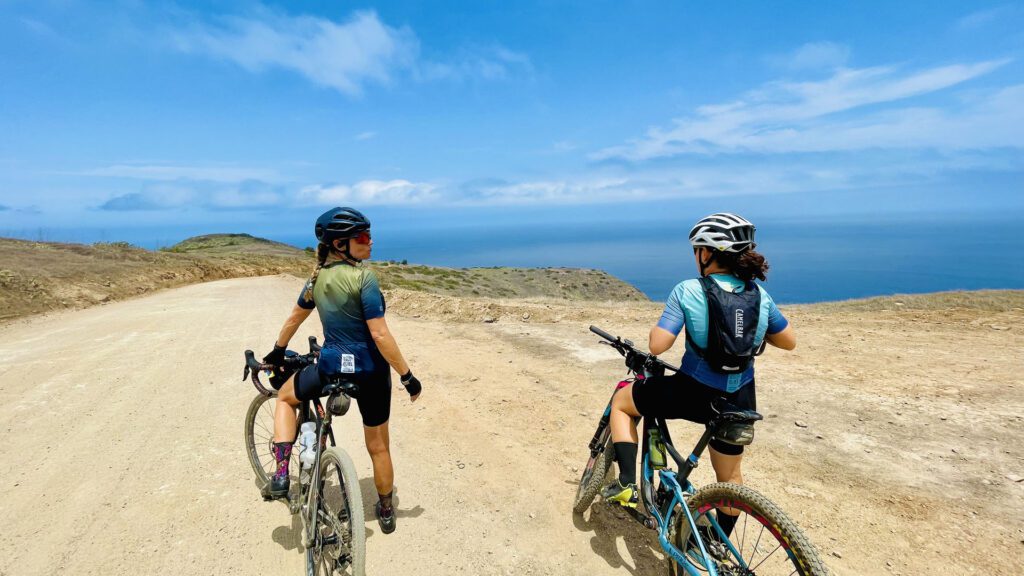
Bring your gravel bike or mountain bike and be prepped for lots of bumpy, unpaved roads but spectacular views!
Bike Permits for Catalina Island: Give Back and Enjoy Your Ride
Biking is a great way to see the interior of Catalina! However, you will need to purchase a Freewheeler Bike Pass from the Catalina Island Conservancy to ride past the gates at either Two Harbors or Avalon to reach the interior of the island.
The cost for an annual membership is $35 for 1 person or $65 for 2 people. As the Catalina Island Conservancy protects and restores native habitats, including keeping track of all those bison, you can feel good about making the purchase. Need more reason? Making this small gift, which is tax-deductible, supports an organization that protects over 88% of the island!
Have a larger group? You can add on to your Catalina Island Conservancy membership level depending on how many riders are in your group! Lastly, if you are renting a bike, the rental company should include the bike permit in the cost of your rental.
Bike Fitness
So, this is the area I was lacking in. Being fit on the bike is different than just having a healthy, active lifestyle. I surf regularly, run a few days a week, yoga a few more days, but have been slacking on riding consistently. My 2 days a week of riding were not enough to feel fit for the epic day of riding to Two Harbors and back. 48 miles and 7,000ft of climbing is no joke on gravel roads!
Climbing back out of the interior in 80+ degree weather made for a few rough hours for me, and my adventure partners! It was like getting off the couch and riding the BWR (Belgian Waffle Ride) Wafer version. Therefore, I do not recommend attempting this crossing without a bit of cycling fitness. Other options? Arrange to have a shuttle meet you, or make a ferry reservation to take you back!
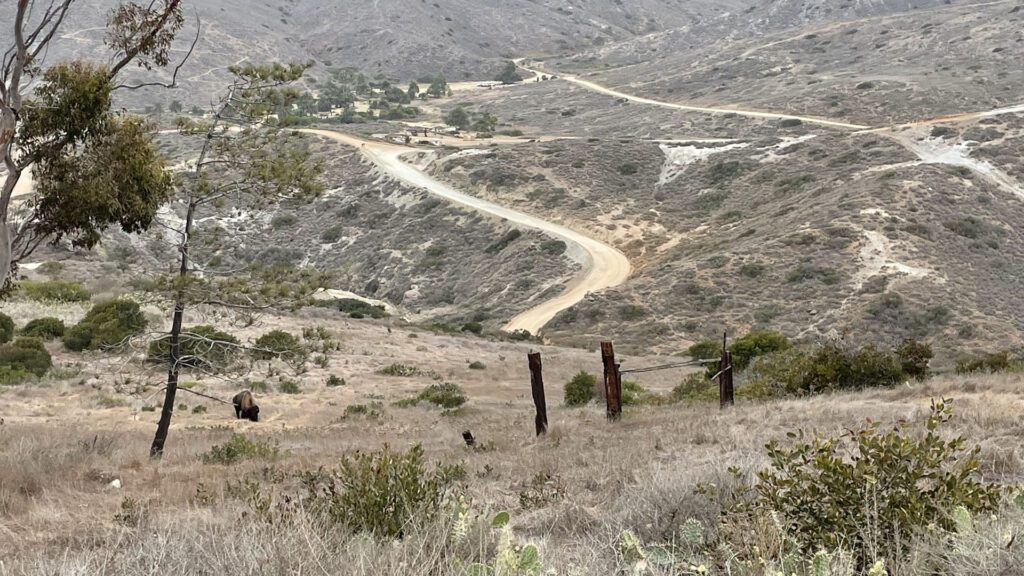
On almost every route there is an opportunity to see bison grazing across Catalina!
What To Pack for Visiting Catalina Island by Bike
Extra Water
There is “water, water everywhere, but not a drop to drink.” Meaning you will have gorgeous ocean views on many of your routes around the island, but very little access to freshwater. Catalina is an arid, low-humidity environment. Therefore, dehydration and heatstroke or heat exhaustion are always risks. Having a Camelbak is almost essential for the long days. On a warm sunny day, you can lose up to 1 liter of water an hour just standing still. Never mind pedaling a bicycle uphill!
When pedaling from Avalon to the Airport in the Sky, you can get by with 2 bottles and easily refill them at the airport cafe. They also have packaged snacks, and a grill at the airport, along with water for sale. And if you ask nicely and are buying other items, they may even refill your bottles behind the counter!
When riding in between the Airport in the Sky and Two Harbors there is hardly anywhere to fill your bottles. Meaning you could be out for 2+ hours without a chance to refill. Often longer depending on your fitness and how many stops you make to take photos! So, buy an extra small bottle or two of water if you did not bring a Camelbak and tuck them in your jersey pocket or burrito bag.
On-the-bike nutrition
While Avalon is a quaint tourist town, and they do have a Vons grocery store, there are not a lot of shops where you can buy ride snacks. Come with your usual nutrition, and for long days, it’s nice to make some PB&Js for the journey.
Helmet
Helmets are required when biking in the interior. And you’ll be happy to wear it when you see some of the steep dirt sections!
Cycling Shoes for Gravel Riding and MTB
Having clipless pedals, meaning shoes that clip into your pedal, I know, sounds counter-intuitive, will definitely help you get to where you are going faster. There is a lot of climbing! Therefore, a flat pedal and sneakers will not work as well but could be more comfortable on the gravel and dirt roads. And allow you to pack less if you’re camping.
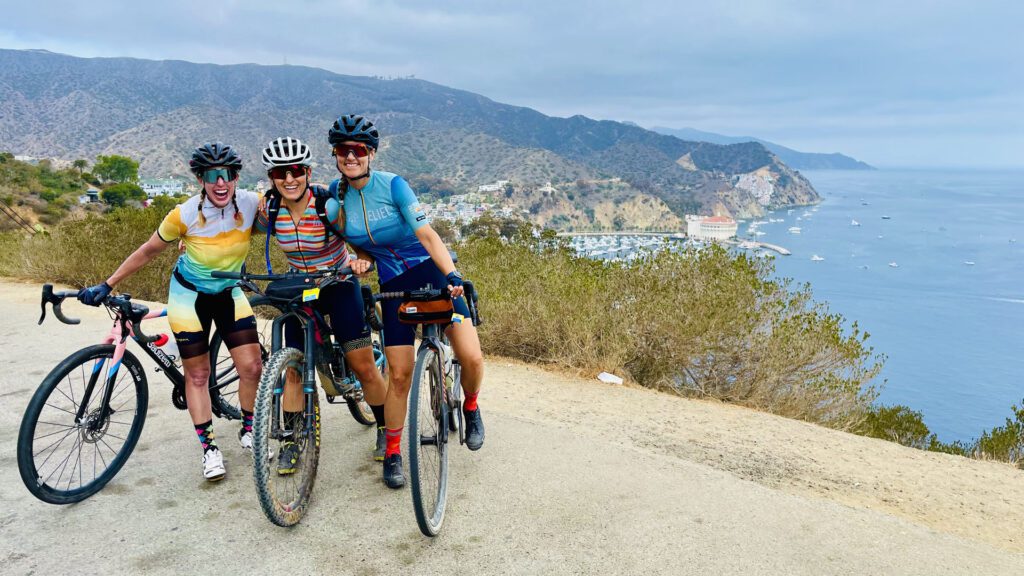
Don’t go this alone. Bring some friends along for the ride to make the long days more fun!
A fully charged cell phone, Garmin cycling computer, and maybe a SPOT tracker
Once you travel a few miles outside of Avalon or Two Harbors, you will begin to lose cell service. There will be service at the Airport in the Sky, and at the top of some of the climbs, but be prepared to not have any service in other parts of the island. Especially in areas like Little Harbor or Middle Fork Ranch.
Therefore, make sure your cell phone is fully charged, along with your Garmin, and you could carry an extra power pack to recharge. If your cell phone tends to die early, put it in airplane mode. Having a device like a SPOT Tracker or Garmin In Reach can also put your family’s mind at ease. And make your group feel more comfortable when you’re exploring the interior!
Go Pro, travel camera, or easy access to your smartphone
YOU WILL STOP FOR PHOTOS. Even if that’s not your thing. You just can’t help it with the incredible vistas. And the bison lingering by the side of the road.
Bike repair kit
Extra tubes, bacon strips, CO2 cartridges, hand pump, sealant, whatever you usually take for a longer day on a mountain bike or gravel ride. If you have a mechanical that you can’t fix on your own, you will have to hike until you have cell service and call Catalina Taxi & Tours or Catalina Island Conservancy Park Ranger to come and rescue you.
Do not depend on a passing car for help. They can be few and far between in the interior. We rode for hours without seeing another cyclist or car on the road.
People repair kit
We ALWAYS carry some kind of emergency medical kit for long days in the backcountry. And biking across Catalina’s interior should be thought of as backcountry. Especially because if there is an accident, you may be at least an hour or longer before you reach help.
Adventure Medical Kits are our favorite and they have several different types of kits depending on the activity, length of your journey, people in your party, etc.
We often pack a larger kit if we’re carrying a backpack, and a smaller, pocket-sized one if we’ll just be out riding for a few hours with no cell service or shops nearby. Having items like moleskin, antihistamine, caffeine tabs, band-aids, and adhesive tape can save the day!
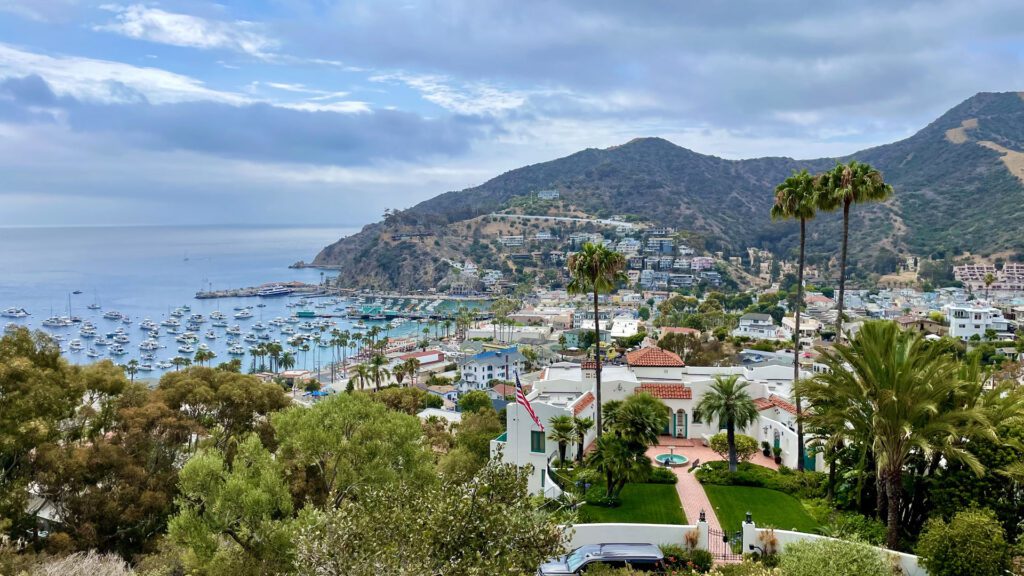
Most visitors will begin their Catalina cycling by pedaling uphill from Avalon. Make sure to stop to take in the views!
Bike Routes and Catalina Island Maps
Download the Catalina Island Conservancy Map. It’s worth taking a look at this before you choose your routes around the island. You can view all the details, like distances, where to find potable water, camp, or if you are hiking while you’re here, where to hop on the Trans Catalina Trail. Keep in mind, you can only bike about 8 miles of the Trans Catalina Trail. It’s designed more for hikers, but more on that later.
Catalina Bike Route #1: Avalon to the Airport in the Sky
Biking from Avalon to the Airport in the Sky is about 10 miles, 1,550ft of climbing, with an average grade of 8.2%.
Depending on where you begin, settle in for a steep, long climb on a paved road for the first 3 miles, taking you up over 1,400 ft. Then make way for lots of rollers with sections of broken pavement mixed with dirt and gravel.
Although the grade of the road comes down to about 4% on the climbs, it still feels like a trek. There may be a few cars, Hummer tours, and taxis coming and going from the airport so stay alert as they sneak up quickly!
Keep an eye out for bison and the island foxes as you make your way up to the Airport in the Sky. Plan to stop into DC-3, the airport restaurant where you can grab burgers, refill water, pick up souvenirs, and try their famous cookies!
Catalina Bike Route #2: Airport in the Sky to Little Harbor
Biking from the Airport in the Sky to Little Harbor is about 6.5 miles with 1,646ft of descending, with an average grade of 5.4% on gravel roads.
From the Airport in the Sky, you will turn right onto El Rancho Escondido Road and take this all the way down to a sharp right onto Little Harbor Road.
Be prepared for mostly packed dirt and gravel, loose in some sections, but easily navigable. Here at Little Harbor, you find several secluded beaches and Little Harbor Campground. There are no services, but there is potable water, and there are port-o-potties at camp!
You may also get cell service up on the bluff, just before you descend into camp. This is also a great place to stop for photos! We also spotted 2 bison on this route, just off to the side of the road. You may not see any vehicles at all on this segment.
Catalina Bike Route #3: Little Harbor to Two Harbors
From LIttle Harbor to Two Harbors is where you will begin to climb again. Settle in for about 850ft of climbing, over 3.8 miles at 4.2% on packed dirt and gravel roads. You will pass a small bathroom (compost toilet) just outside a farm. Keep an eye out for bison here as we saw a huge herd on the hillside! Once you reach the top, with another incredible view, you begin descending again. 2.2 miles, 775ft, with an average grade of 6.5% on the gravel descent.
You will have to slow to pass through a gate and then descend a bit more into Two Harbors. Road conditions are packed dirt, gravel, and a bit sandy. Once again, stay alert as there may be vehicles on the descent!
Once in Two Harbors, you’ll pass the Two Harbors Campground, restrooms, and then the General Store.
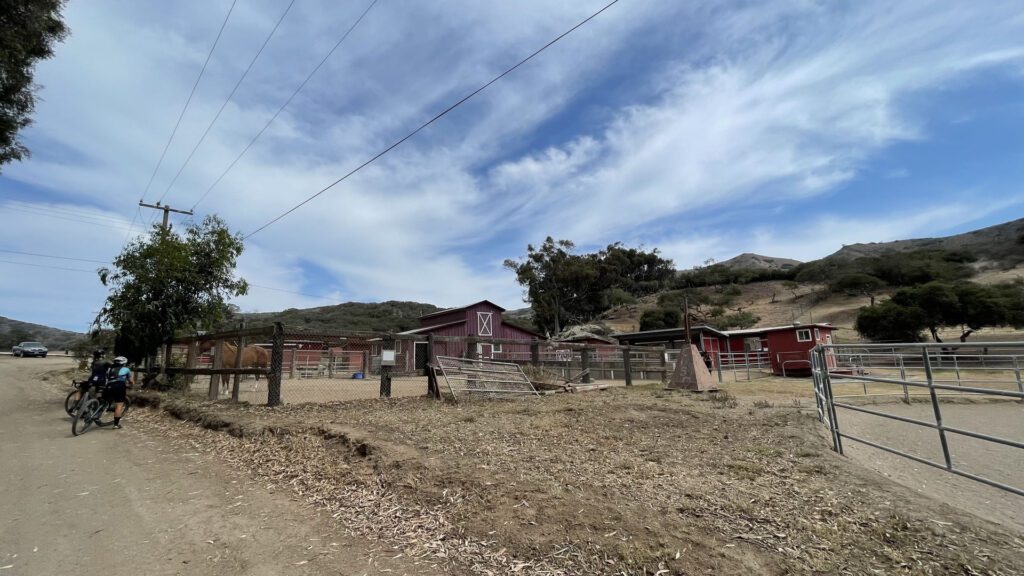
When you climb up Middle Ranch Road, prepare for over an hour of uphill. And make sure to say hi to the horses when you pass the ranch!
Catalina Bike Route #4: Two Harbors to Avalon via Middle Ranch
If you haven’t arranged to stay in Two Harbors, see below for accommodations, it’s now time to make your way home. Make sure to grab an extra bottle or two before rolling out on those harsh gravel roads!
Climbing out seems exhausting by this point, and at a 6.5% gradient for 2.2 miles and 775ft, it certainly is. Once you reach the summit, it’s back to descending again into the interior. You’ll descend for about 4 miles, 850ft, and at a 4.2% grade on gravel. Keep an eye out for island foxes and bison!
As you reach Little Harbor, instead of turning up El Rancho Escondido Road, you will keep going towards the coast onto Middle Ranch Road. Remember to top off water here if you need to.
The views are phenomenal. There’s even a lookout off-shoot trail to the East that takes you to a beautiful overlook of Cottonwood Beach and Ben Weston Beach. Both of these spots are rarely visited on Catalina, and you are allowed to camp here!
Plan on pedaling over some gravel rollers as you turn inland, and then it’s time for the big climb out of the interior and up to Avalon Vista. This is where it gets warm, especially in the afternoons. Settle in for about 7 miles, 1285ft of climbing, and at about a 4% grade.
This was the most brutal part of my day. But if you have great friends in tow, they will make it less painful. And give you all their snacks and water!
Once you reach the summit, make a right and pedal past Haypass Recreation Area. Here’s your next chance to get water. But you may not need it, as it’s all downhill from here. The descent is about 3 miles, 1450ft of descending at an 8% grade back into Avalon on the paved road.
More Routes Plus the Trans Catalina Trail
Want more routes? Search Strava and Ride with GPS to see what other options you can link together. Keep in mind, for the safety of hikers, and the enjoyment of cyclists, bikes are permitted on about eight miles of the Trans-Catalina Trail.
To get there, ride through town and climb the paved road up towards the Wrigley Mansion. Just before the scenic overlook, there will be a left onto Renton Mine Road. Take this to East End Road, and then Divide Road to Dakin Peak (the microwave tower) on the East End.
Having the Catalina Island Conservancy Map in hand, or just take a photo of it, will be helpful to find your way around.
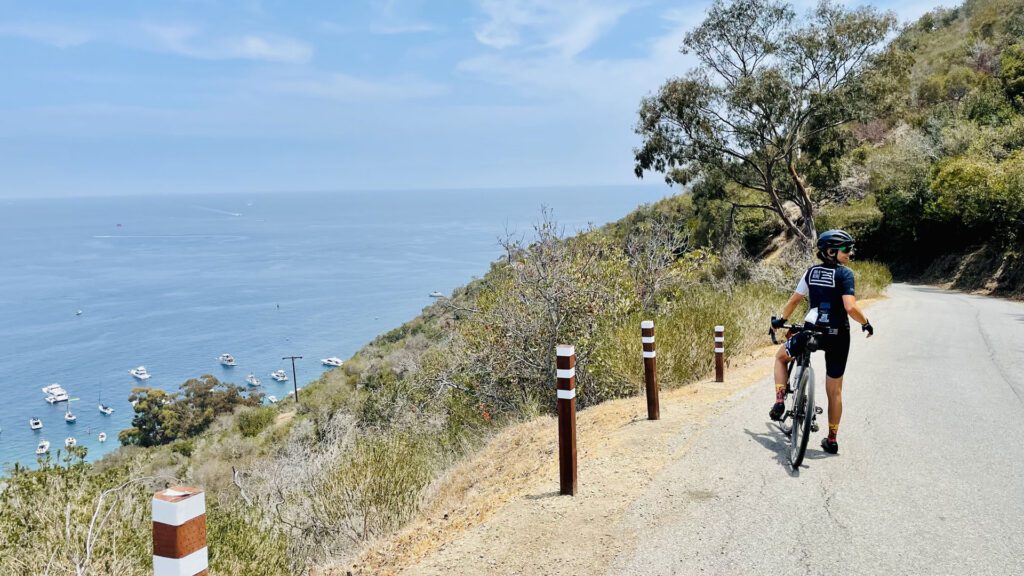
When you ride between Avalon and the Airport in the Sky, you’ll be on some of the only paved roads outside of town!
Travel Tips for Planning Your Catalina Trip
When and How to Travel to Catalina
Most people visit Catalina between May and October when the ferry crossings are plentiful, and you have a better chance of good weather. Catalina can be accessed by ferry from San Pedro, Long Beach, or Dana Point.
Check out the Catalina Express or the Catalina Flyer to make a reservation. Boats do fill up in the summer months.
You can also sail to Catalina on your private boat or with a tour, just make sure to obtain a mooring or boat-in camping spot in advance. Other options? Fly by private plane or helicopter to the island.
What You Will See: Nature and Wildlife on Catalina Island
The bison on Catalina is a big draw for many tourists, but there’s also the island fox, rattlesnakes, mule deer, antelopes, and dozens of species of birds, bats, and butterflies! Read more about the Catalina Island conversation programs.
If you’ll be getting in the ocean, pack a wetsuit for diving and at least a 1mm jacket for snorkeling. The water is incredibly clear but cold! Only about 65-70 degrees in the summertime. You’ll have the opportunity to spot lots of bright orange Garibaldi, California’s State Fish, sea lions, stingrays, and lots more.
Check out Diving Catalina to arrange for a dive trip or snorkel tour.
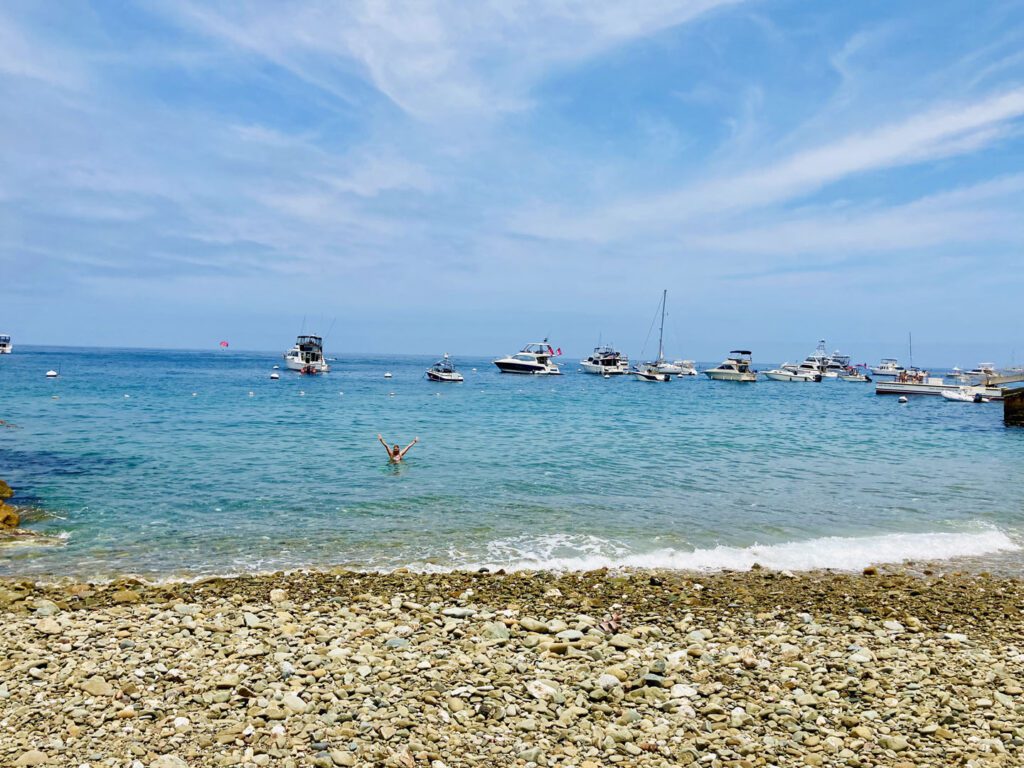
Make sure you leave some time to recover and soaking in the ocean instead of an ice bath is one of our favs here in Hamilton Cove!
Where to Stay on Catalina for a Biking Trip
There are lots of options for where to stay in Catalina, whether you select a hotel, Airbnb, or camp! Check out LoveCatalina.com to check rates and availability. Bike packing and camping on Catalina could be a great adventure. Just make sure to reserve a Catalina campsite well in advance!
Where to Eat: Dining out in Catalina
- Bluewater Grille
- Steve’s Steakhouse- great fine dining with views over the harbor. Say hi to Steve for us!
- Cafe Metropole
- Maggie’s Blue Rose
- The Lobster Trap- you can also pick up fresh fish here to go!
- Avalon Grille
- Descanso Beach Club– just north of Avalon, this is a great spot to enjoy the beach, cocktails by the ocean, and a nice dinner!
- Toyon Grille- just next to the Catalina Island Conservancy shop.
Other Things to Do on Catalina
There’s lots of free beach access, but we recommend walking or biking to the Descanso Beach Club, Hamilton Cove, or Lovers Cove to escape the crowds in Avalon. Bring your snorkel gear as the water is quite clear but cold!
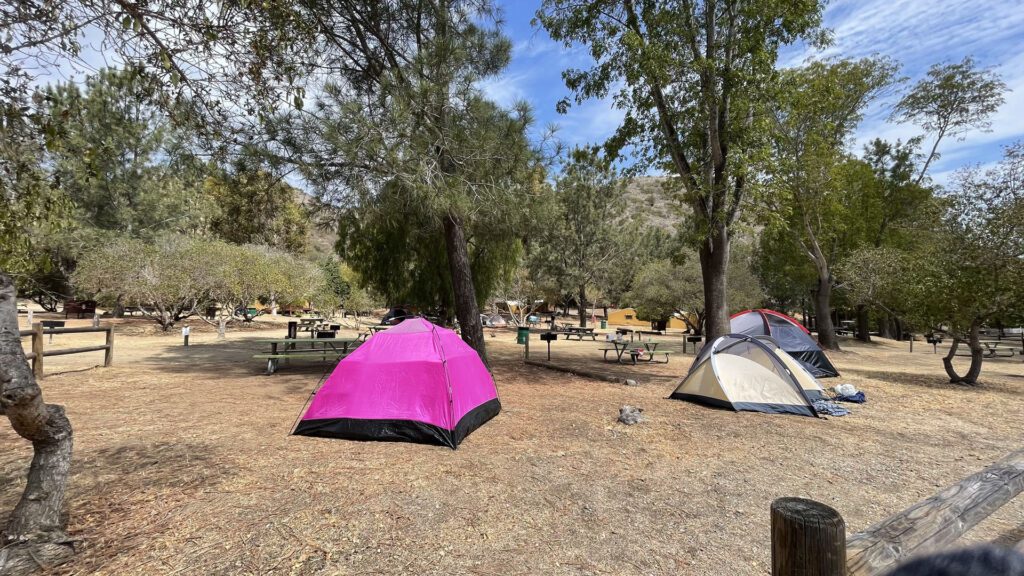
There are lots of campsites available across the island, but be prepared for dirt and sandy spots, and not very much shade!
More Resources to Help You Plan Your Catalina Trip
- Love Catalina Island
- Catalina Above and Below– check out their Instagram images or reach out for Island Tours!
- SoCal Bike Tours: Mountain Biking on Catalina
Want more travel tips? Read more of Top Rope Media’s travel blogs:
- Backpacking in the Wind River Range in Wyoming
- Camping in Joshua Tree National Park
- Road tripping through Utah’s National Parks
- Driving California’s 395 to Bishop, Mammoth Lakes, and Yosemite National Park
Keep up on our latest adventures by subscribing with your email below, or follow us on Instagram, Facebook, or Twitter.
Until next time, happy traveling!
– Meredith McConvill
Recent Comments